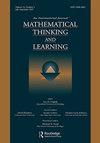Connecting mathematical modeling and social justice through problem posing
IF 1.5
4区 教育学
Q2 EDUCATION & EDUCATIONAL RESEARCH
引用次数: 5
Abstract
ABSTRACT This paper contributes to accumulating the knowledge base about prospective elementary school teachers’ (PTs’) understanding of socio-critical modeling by exploring how PTs make connections to features of mathematical modeling and social justice while posing mathematical problems and reflecting on their problem-posing. We present a conceptual framework for posing problems that connect social justice issues with the features of mathematical modeling. Drawing on the analysis of 36 individual modeling problems generated by the PTs and 36 written reflections PTs completed throughout their problem-posing activity, we illustrate various ways in which PTs connect the multi-faceted features of mathematical modeling (i.e., realistic context, model development, and shareable process) and social justice (i.e., micro – and macro – level). The PT-posed problems were categorized as (a) modeling problems presenting micro – and macro-level social justice issues (27%), (b) modeling problems presenting micro-level social justice issues (22%), (c) contextualized mathematical problems presenting micro – and macro-level social justice issues (25%), and (d) contextualized mathematical problems presenting micro-level social justice issues (17%). Our work describing the complexity of posing social justice-oriented mathematical modeling (SJMM) problems and articulating decisions PTs make while posing SJMM problems set directions for future efforts and research in teacher preparation.通过问题提出将数学建模与社会正义联系起来
摘要本文通过探讨未来小学教师在提出数学问题时如何将数学建模与社会正义的特征联系起来,并对其提出的问题进行反思,有助于积累他们对社会批判建模理解的知识基础。我们提出了一个概念框架,提出了将社会正义问题与数学建模的特征联系起来的问题。通过对学生们产生的36个独立建模问题的分析,以及学生们在提出问题的过程中完成的36个书面反思,我们说明了学生们将数学建模的多方面特征(即现实背景、模型开发和可共享过程)与社会正义(即微观和宏观层面)联系起来的各种方式。pt提出的问题被分类为(a)呈现微观和宏观社会正义问题的建模问题(27%),(b)呈现微观社会正义问题的建模问题(22%),(c)呈现微观和宏观社会正义问题的情境化数学问题(25%),以及(d)呈现微观社会正义问题的情境化数学问题(17%)。我们的工作描述了提出社会正义导向数学模型(SJMM)问题的复杂性,并阐明了学生在提出SJMM问题时所做的决策,这为教师准备的未来努力和研究指明了方向。
本文章由计算机程序翻译,如有差异,请以英文原文为准。
求助全文
约1分钟内获得全文
求助全文
来源期刊

Mathematical Thinking and Learning
EDUCATION & EDUCATIONAL RESEARCH-
CiteScore
4.40
自引率
6.20%
发文量
18
 求助内容:
求助内容: 应助结果提醒方式:
应助结果提醒方式:


